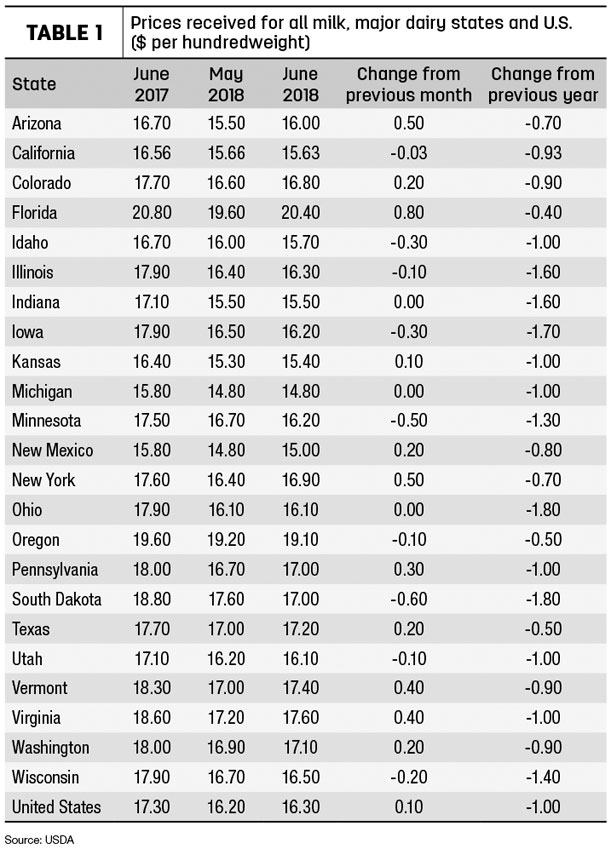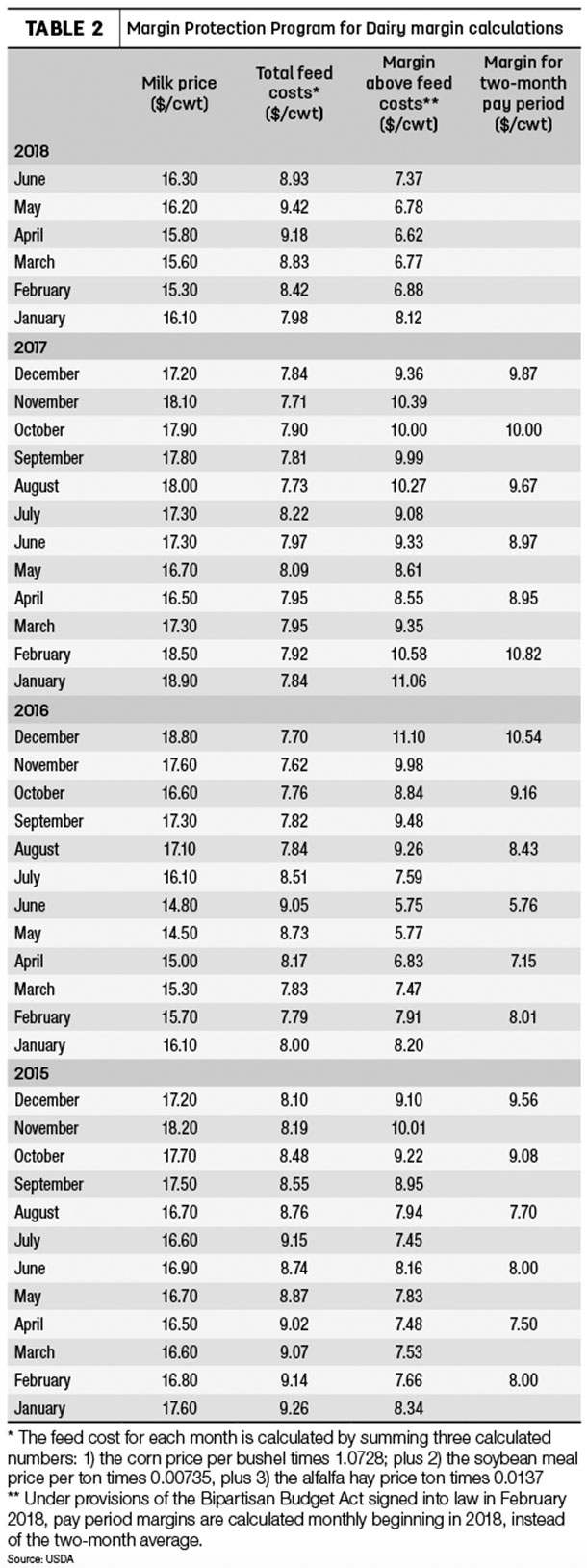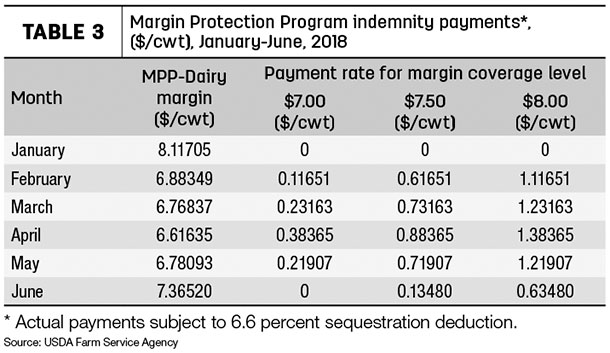June 2018’s Margin Protection Program for Dairy (MPP-Dairy) margin calculations ended a four-month string below $7 per hundredweight (cwt), but dairy producers who purchased coverage at the $7.50 and $8 per cwt margin levels will receive indemnity payments for a fifth consecutive month.
Milk price up just a dime
The June U.S. average milk price improved just 10 cents per cwt from May to $16.30 per cwt (Table 1). The June 2018 average was $1 less than June 2017. Through the first half of 2018, the average milk price stands at $15.88 per cwt compared to $17.53 per cwt in the same period of 2017.

Compared to a month earlier, June milk prices among the 23 major dairy states ranged from 50 cents higher (Arizona) to 60 cents lower (South Dakota). Florida’s average of $20.40 per cwt remained the nation’s high. The low was $14.80 per cwt in Michigan.
Compared to a year earlier, June 2018 milk prices were lower in all 23 states, led by declines in Ohio and South Dakota (-$1.80) and Iowa (-$1.70). Fourteen of the 23 states posted declines of $1 per cwt or more.
Feed prices dip
June 2018 U.S. average feed prices declined about 50 cents from May to $8.93 per cwt of milk sold (Table 2). The soybean meal price fell nearly $38 per ton from May; the U.S. average corn price dropped 9 cents per bushel; and the alfalfa hay price declined $8 per ton.

MPP-Dairy margin moves above $7 per cwt
With the lower feed costs, the national average margin was $7.36 per cwt in June, the largest since January. Dairy farmers who enrolled in MPP-Dairy and elected $7 per cwt margin coverage won’t see a payment for milk marketed in June, and those insured at the $7.50 and $8 margin levels will see smaller payments than the previous four months.
Dairy farmers insured at the $8 per cwt margin level will receive a base payment of about 63.5 cents per cwt on June milk (Table 3), less the 6.6 percent sequestration deduction and any premium costs. Producers insured at the $7.50 margin level will see a base payment of about 13.5 cents per cwt.

For example, insured at the $8 level, a dairy herd with annual production history of 6.25 million pounds of milk and electing to cover 80 percent of that milk (5 million pounds) would be eligible for payment on 4,167 hundredweights (5 million pounds divided by 100 divided by 12) per month. The 4,167 hundredweights multiplied by about 63.5 cents per cwt would yield a base payment of $2,646 for June. Subtracting the sequestration deduction of about $175, the payment drops to about $2,471. That does not include any deductions for premiums. Payments are issued directly to producers via electronic deposit; there are no paper checks.
While June’s MPP-Dairy margin improved, weaker dairy commodity prices in July, in part due to increased trade uncertainty related to Chinese and Mexican tariffs on U.S. dairy products, mean the July margin could descend to levels seen in February through May. As of July 27, the Program on Dairy Markets and Policy projected July’s margin to fall back below $7 per cwt, triggering a MPP-Dairy payment of about $1.20 per cwt for those insured at the $8 per cwt margin.
Projected margins are expected to climb back to $7.50 per cwt in August and $8 per cwt in September.
2018 MPP-Dairy premium balance deadline extended
The deadline to pay all remaining 2018 MPP-Dairy buy-up premium balances has been extended to Sept. 28, according to Danielle Cooke, acting deputy administrator of farm programs with the USDA Farm Service Agency. The original deadline for calendar year 2018 MPP-Dairy buy-up premiums was Sept. 1.
In a notice to USDA FSA state and county offices, Cooke said the extension will help ensure all MPP-Dairy participants have received all eligible payments before premiums are due.
More producers, less milk enrolled in 2018
When final enrollment numbers are tallied, more than 21,250 dairy operations will have covered about 131 billion pounds of milk under MPP-Dairy in 2018, representing about 60 percent of the U.S. milk supply, according to John Newton, chief economist with the American Farm Bureau Federation (AFBF). Read: Dairy MPP Is delivering in 2018: Even more help is on the way.
The total number of dairy farms enrolled in MPP-Dairy for 2018 is up nearly 1,000 farms (5 percent) from 2017 enrollment levels, but the amount of milk covered is down 14 billion pounds. Newton said the decline in milk covered is likely due to producers seeking to stay within the Tier I (5 million pounds of milk) level, which offers dramatically lower premium costs.
Only 23 percent and 7 percent of participating dairy operations elected buy-up coverage above the catastrophic $4 per cwt coverage level in 2016 and 2017, respectively. For 2018, 95 percent of the enrolled dairy operations elected buy-up coverage, and many of those farms elected the highest coverage level – $8 per cwt.
USDA’s flexibility in allowing farmers to finalize coverage options until June 22 contributed to the upturn in buy-up coverage participation, Newton said. By then, farmers knew MPP-Dairy payments had been triggered at the $7 through $8 coverage levels from February through April.
As of early July, USDA has made over $155 million in MPP-Dairy program payments, with the average payment rate through May averaging $7,400 per dairy operation, or 29 cents per cwt. Read: State MPP-Dairy payments listed; LGM-Dairy participants on outside.
To receive these and future benefits, dairy farmers across the U.S. paid more than $65 million in premiums and administrative fees – resulting in a current net benefit of more than $91.5 million.
While the outlook is for MPP-Dairy payments to end this fall, the timing should coincide with a USDA plan to assist dairy farmers and other agricultural producers affected by the ongoing tariff war, beginning some time after Labor Day.
Read: Trump administration plans to offset dairy, ag trade retaliation impact
This fall may also bring additional improvements to the U.S. dairy risk management toolbox. Both House and Senate versions of the 2018 Farm Bill include further improvements to MPP-Dairy. In addition, the long-awaited launch of the Dairy Revenue Protection program, developed by AFBF, is expected this fall. Read: What is Farm Bureau’s Dairy-Revenue Protection?
“Combined, the enhanced MPP, Dairy Revenue Protection and other risk management tools will provide a much more robust set of risk management tools for dairy farmers going forward,” Newton said. ![]()

-
Dave Natzke
- Editor
- Progressive Dairyman
- Email Dave Natzke








